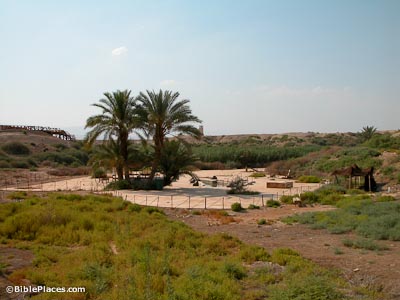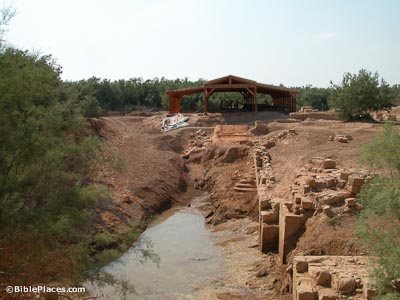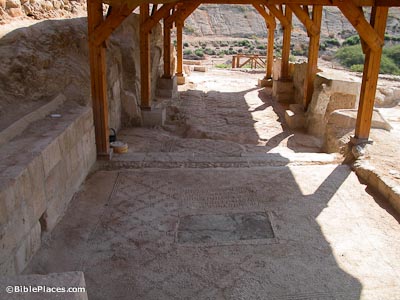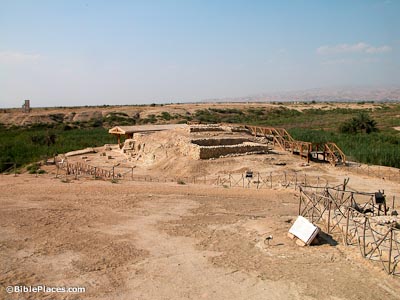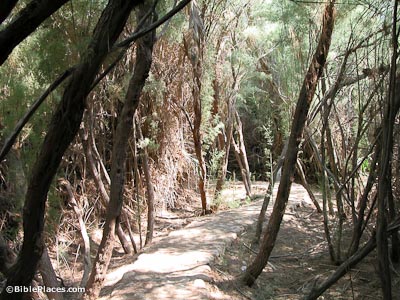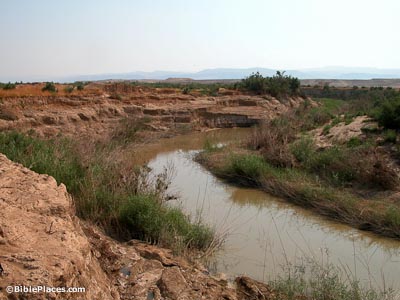Wadi Gharrar is a small tributary of the Jordan River that is fed by about five springs. Tradition holds that these springs provided the water that was used by John the Baptist for baptizing. Those who support this tradition note that (1) “Bethany beyond the Jordan” was not necessarily a location on the river itself; (2) this site is closely connected with the river; and (3) it was unlikely that a swiftly flowing river like the Jordan would have been used for frequent baptisms.
Bethany Beyond the Jordan
Chapels
Fifty yards from the Jordan River, the Byzantines built three churches here to commemorate Jesus’s baptism by John. The earliest church was built on stilts because of flooding. This site is located near the southern end of the Jordan River, across from Jericho.
Rhotorios Monastery
Despite the early tradition associated with this site, its identification as “Bethany beyond the Jordan” is probably incorrect. Instead, the northern Bethany in the territory of Herod Philip fits a number of points in the New Testament record. It is possible that Jesus was baptized in the southern part of the Jordan River (near Jericho) and, after His temptation, He met John in the region of the northern Bethany.
Elijah's Hill
Byzantine tradition connected Elijah’s ascension into heaven (in a whirlwind, at the appearance of a chariot of fire) with the same area as John’s baptisms. Scripture only says that Elijah was taken to heaven on the other side of the Jordan. The 6th-century pilgrim Theodosius refers to this hill, called at the time “Hermon.” A number of Christian buildings were erected at Elijah’s hill, including the Rhotorios Monastery, the Cave Chapel, and the “Arch Church.”
The "Pride" of the Jordan
The thickets surrounding the Jordan are referred to in scripture as the “pride” of the Jordan (Zech 11:3). Especially prevalent in this growth are tamarisk, willow, and Euphrates poplar trees. Since the growth is so thick, wild animals find refuge in this area. Nineteenth-century explorers reported seeing lions, tigers, bears, hyenas, jackals, and otters. Jeremiah used the image of a lion coming up from the Jordan’s thickets in his prophecies (Jer 49:19; 50:44).
Jordan River
Because large quantities of water are taken from the sources of the Jordan by the countries of Israel and Jordan, the river today is a small, winding, dirty stream that makes its way to the Dead Sea. The river winds so much on its journey from the Sea of Galilee to the Dead Sea that the entire course runs about 130 miles (210 km) instead of the 60 miles (96 km) it would take if it ran straight.
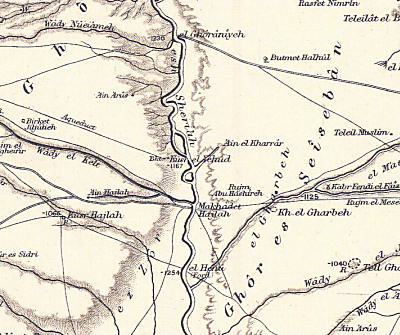
Survey of Eastern Palestine
This map shows the area of the southern end of the Jordan River in the 1880s, as recorded by the Palestine Exploration Fund. This map is included in high resolution in the Survey of Western Palestine: The Maps collection. For a careful discussion of the correct location of Bethany beyond the Jordan, see this article (pdf) by J. Carl Laney.

Download all of our Jordan photos!
$34.00 $49.99 FREE SHIPPING
Related Websites
See our Animals of the Bible page. For historical images of the Jordan River and baptism sites, see Life in the Holy Land. For a related Bible chapter, see Mark 1.
The Identification of Bethany Beyond the Jordan (BiblePlaces.com) A detailed examination of various possible locations, from the doctoral dissertation of J. Carl Laney. PDF format.
Bethany Beyond the Jordan (See the Holy Land) This is a good introduction to the site and its features.
Bethany-Beyond-The-Jordan (Sacred Destinations) This article has a helpful section on the site’s history.
Bethany Beyond the Jordan (Catholic Encyclopedia) Presents the evidence for preferring the reading “Bethabara” over “Bethany,” but in the end settles on “Bethany.”
Bethany-Beyond-The-Jordan (Just a Carry On) This page has little text, but its many photos are a fascinating look at the surrounding culture.
